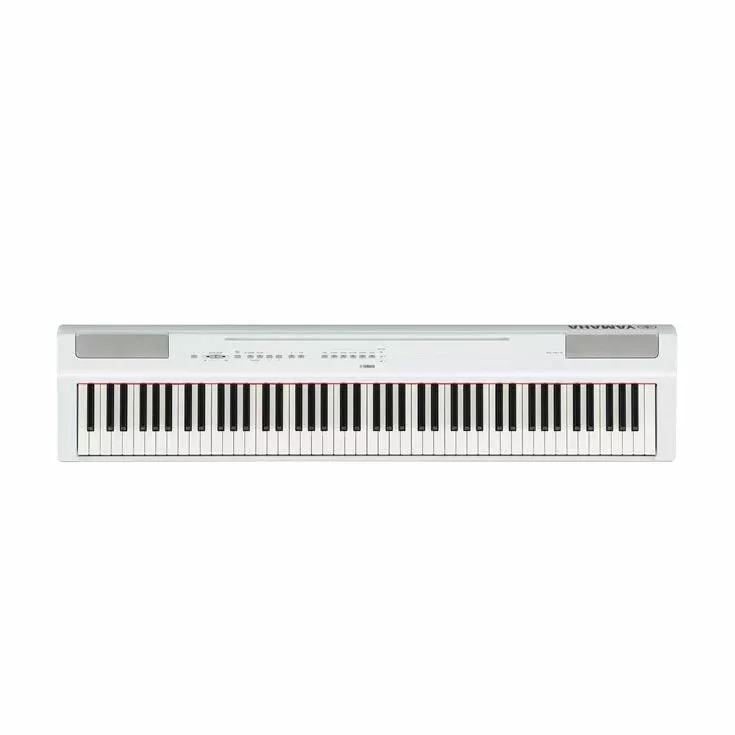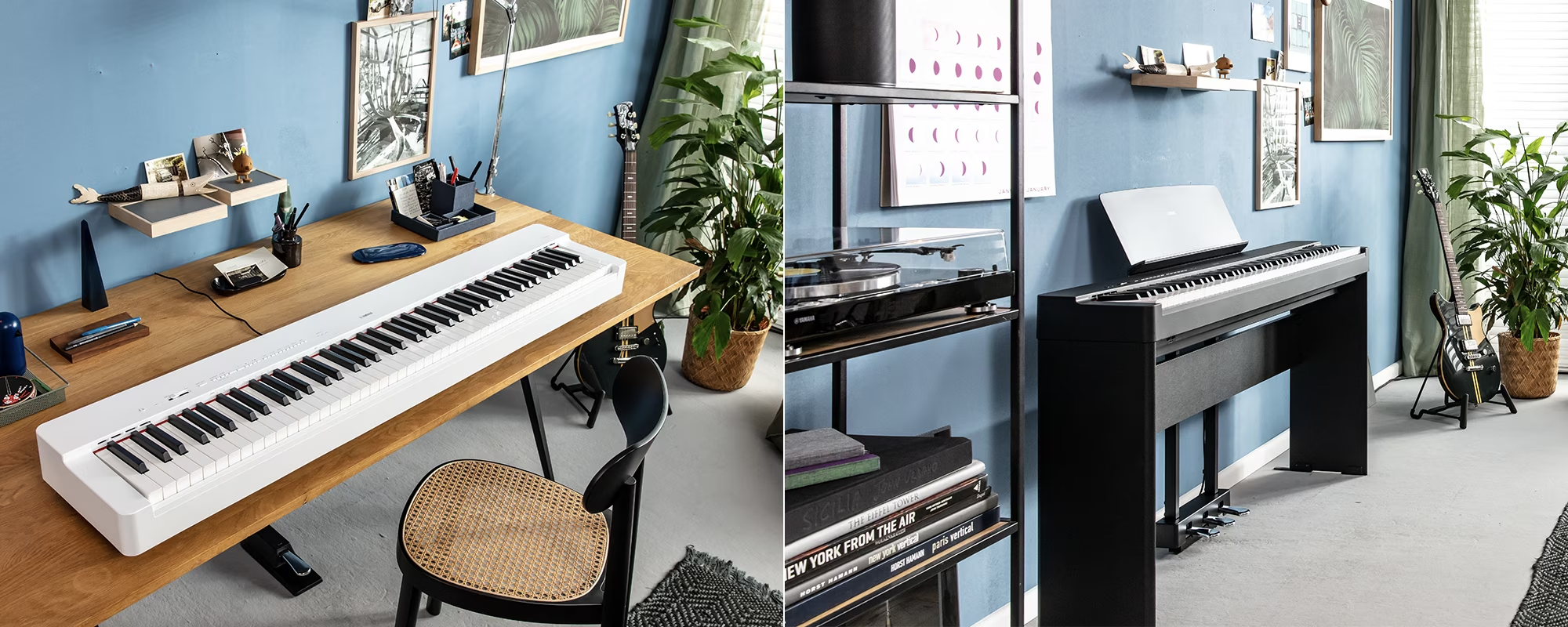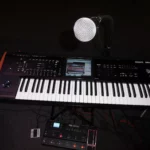
Hey there, music enthusiasts and pianists! Are you on the hunt for the perfect digital piano? Well, you’re in luck! Today, we are going to delve into the world of Yamaha’s pianos, focusing on the Yamaha P125 digital piano.
We’ll also pit it against its siblings, the Yamaha P45, P71, and the Roland FP10, a strong contender from another renowned piano and synthesizer brand.
Yamaha P125 Review: The Best Digital Piano for Beginners?
Contents
- Yamaha P125 Review: The Best Digital Piano for Beginners?
- Yamaha P125 Digital Piano: Main Features
- Yamaha P125 Digital Piano: Sound Quality
- Yamaha P125 Digital Piano: Reverb and Sound Effects
- Yamaha P125 Digital Piano: Smart Pianist App Integration
- Yamaha P125 Digital Piano: Bass and Drum Beats
- Yamaha P125 Digital Piano: Sound Optimization
- Yamaha P125 Digital Piano: Soundbank
- Speaker System
- Inbuilt Audio Interface
- Yamaha P125: Modes
- Yamaha P125: Functions
- Yamaha P125: Keyboard and Action
- Included Accessories
- Yamaha P125 Digital Piano: Final Thoughts
- Yamaha P125 Digital Piano: Comparisons
- Yamaha P125 Specifications
- FAQs
- Conclusion
Yamaha P125 Digital Piano: Main Features

The Yamaha P125 digital piano, a member of the illustrious P-series, is a compact and portable digital piano that combines incredible piano performance with a user-friendly, minimalistic design. This instrument is for both beginners and seasoned players.
Let’s break down its features:
Sound Quality
The P125 boasts Yamaha’s Pure CF Sound Engine, delivering a rich and nuanced tone that’s as close to an acoustic piano as you can get. It’s like having a concert grand right in your living room!
Key Action
With its Graded Hammer Standard (GHS) keyboard, the P125 offers a heavier touch at the low end and a lighter touch at the high end, mimicking the hammers inside an acoustic piano. It’s a real treat for the fingers!
Connectivity
The P125 offers USB-to-Host connectivity and an inbuilt audio interface, allowing you to connect your piano to your computer or mobile device for a wide range of music-related applications. Talk about convenience!
Yamaha P125 Digital Piano: Sound Quality
The P-125 allows for incredible dynamics and expressiveness.
The Pure CF Sound Engine includes the sound of the renowned Yamaha CFIIIS 9′ concert grand piano. It is the result of over a century of acoustic piano craftsmanship combined with state-of-the-art technology and expertise.
In addition, the Graded Hammer Standard (GHS) 88-key piano keyboard provides a heavier touch in the low end and a lighter touch in the high end, so it can be played with the expressiveness of an acoustic piano.
The newly improved 2-way speaker system also helps to produce an expansive piano sound in both upward and downward directions. This gives the player a rich stereo sound as if you were sitting at an acoustic piano.
Yamaha P125 Digital Piano: Reverb and Sound Effects
The P125 primarily offers reverb as its sound effect. While this might suffice for some, those looking to play in bands or record might desire additional effects. The available reverb types include Concert Hall, Chamber Hall, Club, and Recital Hall.
While they have subtle differences, they generally serve the same purpose. Concert Hall provides the most resonance, while Club offers a more intimate sound. However, many might find themselves rarely adjusting these settings after initial exploration.
Yamaha P125 Digital Piano: Smart Pianist App Integration

The P-125 seamlessly integrates with Yamaha’s Smart Pianist app. This app not only allows users to easily navigate the piano’s features but also offers a Chord Tracker function.
This unique feature analyzes songs from your device’s music library, presenting the chords, and enabling you to play along. It’s a modern touch that enhances the P-125’s user experience.
The Smart Pianist App is available for iOS and Android.
Yamaha P125 Digital Piano: Bass and Drum Beats
P-125 has onboard Bass and Drum tracks that keep you playing in time and follow your harmony.
There’s a variety of rhythm patterns to choose from depending on the vibe you’re going for. From rock to ballads, use these rhythms to add an element of fun to your practicing, or use them as a backing band for your performances.
Yamaha P125 Digital Piano: Sound Optimization

The new “Table EQ” feature enables the player to enjoy optimal acoustics, so even if you play on a hard, flat surface, you get the best possible sound.
Yamaha P125 Digital Piano: Soundbank
The Yamaha P-125 boasts 24 distinct voices, a notable increase from the P-115’s 14. It’s organized into six sound categories:
- Piano Sounds: CFX Grand Piano, Live Grand, Ballad Grand, Bright Grand
- Electric Piano: Stage Electric Piano, FM Electric Piano, Vintage Electric Piano, Synth
- Keyboard Varieties: Harpsichord 1, Harpsichord 2, Clavichord, Vibraphone
- Organ Tones: Jazz Organ, Rock Organ, Organ Principal, Organ Tutti
- String Instruments: Choir, Synth Pad, Slow Strings, String Ensemble
- Bass Varieties: Fretless Bass, Electric Bass, Bass + Cymbal, Acoustic Bass
This instrument comes with 24 high-quality sounds that cover the expected categories, and the P125 ticks boxes.
Speaker System
The P-125 is equipped with a quad-speaker system, two front-facing and two beneath, delivering a combined 14W of power. Yamaha’s design ensures an immersive auditory experience, enveloping the player in rich sound. The speakers are of high quality, producing clear sound without distortion, even at elevated volumes.
However, for those seeking a portable piano for live performances, a more potent speaker system might be desirable. Yamaha introduces innovative features in the P-125, such as Sound Boost, which enhances clarity and volume, and Table EQ, ensuring optimal sound when the piano is placed on a table.
Inbuilt Audio Interface
The Yamaha has an inbuilt interface that allows you to connect the instrument easily to a PC and use the P125 as a Midi Controller. This is a feature that is also found on the Roland FP-30X.
Yamaha P125: Modes
The Yamaha P125 offers three distinct modes:
- Dual Mode: Splits the keyboard, replicating notes on both sides. Ideal for teachers, creating a dual piano effect.
- Layer Mode: Combines two sound selections, like piano and strings or organ and choir.
- Split Mode: Assigns different voices to each hand, such as organ (left) and choir (right).
Yamaha P125: Functions
- Polyphony: Features 192-note polyphony, allowing multiple sounds simultaneously.
- Transposition: Adjusts from -6 to +6 semitones, aiding in key changes.
- Fine-tuning: Tunes the pitch minutely to align with other instruments.
- Metronome: Ranges from 5bpm to 280bpm.
- Recording: Offers 2-track recording for playback analysis.
- MIDI Playback: Connects to computers or apps like Flowkey via USB-TO-HOST.
Yamaha P125: Keyboard and Action

The P125 incorporates Yamaha’s Graded Hammer Standard (GHS) action, which is satisfactory for most pianists. Despite some negative reviews, the GHS action on the P125 is commendable, replicating a genuine piano feel.
Included Accessories
- Music Stand
- Manual
- Power cord
- Sustain pedal/switch
Optional accessories include a Triple Pedal Unit and a piano stand and stool. Consider investing in quality headphones for enhanced sound. You could also consider a regular X-style piano stand if you want.to be able to reposition your piano or perform on stage.

Yamaha P125 Digital Piano: Final Thoughts
The Yamaha P125 offers value for its price. It’s a step up for those transitioning from basic keyboards and offers excellent value for money.
While it might not be a significant upgrade from models like P105 or P115, it serves well as a portable practice instrument for intermediate and professional pianists looking for a practice instrument and a piano to teach on.
Yamaha P125 Digital Piano: Comparisons
Yamaha P125 vs Yamaha P45
So, how does the P125 stack up against its sibling, the Yamaha P45? Well, let’s see:
- Polyphony: The P125 offers a whopping 192-note polyphony, compared to the P45’s 64-note polyphony. That’s a lot more room for complex and layered performances!
- Voices and Rhythms: The P125 comes with 24 voices and 20 rhythms, while the P45 has 10 voices and no rhythms. Variety is the spice of life, after all!
- Sound Boost: This feature, present in the P125 but absent in the P45, enhances the presence of the piano when played in a mix, making it stand out in performance situations. It’s a real game-changer!
Yamaha P125 vs Yamaha P71
The Yamaha P71 is another sibling in the P-series. How does it compare to the P125?
- Design: The P71 is an Amazon-exclusive model and is virtually identical to the P45 in design and features. The P125, on the other hand, offers more in terms of functionality and versatility.
- Sound Quality: While the P71 also uses the AWM Stereo Sampling for sound, the P125’s Pure CF Sound Engine offers a more authentic and richer piano sound.
- Additional Features: The P125’s Sound Boost and Intelligent Acoustic Control (IAC) features give it an edge over the P71, enhancing the overall playing and listening experience.
Yamaha P125 vs Roland FP-30X
Stepping outside the Yamaha family, let’s see how the P125 fares against the Roland Fp-30X.
- Key Action: The Roland FP-30X features Roland’s PHA-4 Standard keyboard, offering high-resolution sensing and escapement for fast key repetition. However, some players might prefer the more realistic feel of the P125’s GHS keyboard.
- Sound: The FP10 uses Roland’s SuperNATURAL Piano sound engine, which is highly regarded for its expressiveness and dynamic range. However, the P125’s Pure CF Sound Engine holds its own with its authentic and rich tone.
- Connectivity: Both pianos offer USB to Host connectivity, but the P125 also features a two-track recorder, allowing you to record and playback your performances.
Yamaha P125 Specifications
| Feature | Details |
|---|---|
| Keyboard | 37 slim-key, velocity-sensitive keyboard (no aftertouch) |
| Type | 4-voice Analog / Digital Synthesizer with 2 VCOs per Voice |
| Oscillators | 2 VCOs (analog) + 1 digital oscillator (multi-engine) |
| Waveforms | Sawtooth, Triangle, Square, VPM, Noise, User (16 slots) |
| Filter | 1 x 2-pole low-pass filter (analog) |
| Envelope generators | 2 x ADSR (filter, amplitude) |
| LFOs | 1 x triangle, sawtooth, square, random |
| Effects | Delay, Reverb, Modulation (Chorus, Phaser, Flanger) |
| Sequencer | 16-step polyphonic sequencer, motion sequencing |
| Arpeggiator | 4 modes (Up, Down, Alternate, Random) |
| Memory | 500 programs (200 Factory, 300 User) |
| Connectivity | MIDI IN/OUT, USB, Sync In/Out, Audio In, Audio Out, Headphones |
| Additional Features | Digital Multi-engine, MIDI/Sync I/O |
| Polyphony | 192 Note Polyphony |
For a complete specification list, and more info on the P125, check out the official Yamaha P125 page:
FAQs
1. Is the Yamaha P125 Good for Beginners?
Absolutely! With its user-friendly design and features, the P125 is a great choice for beginners.
2. How Does the Yamaha P125 Compare to the P45 and P71 in Terms of Price?
The P125 is slightly more expensive than the P45 and P71, but its additional features and functionalities justify the price difference.
3. Is the Roland FP10 a Worthy Competitor to the Yamaha P125?
Yes, the Roland FP10 is a strong competitor with its own set of strengths. However, the choice between the two would depend on personal preference.
Conclusion
In the grand symphony of digital pianos, the Yamaha P125 strikes a harmonious chord. With its superb sound quality, realistic key action, and versatile features, it stands tall against its siblings, the Yamaha P45 and P71, and even the Roland FP10.
Whether you’re a beginner or a seasoned player, the P125 offers a musical experience that’s hard to beat. So, are you ready to tickle the ivories? The Yamaha P125 awaits!







